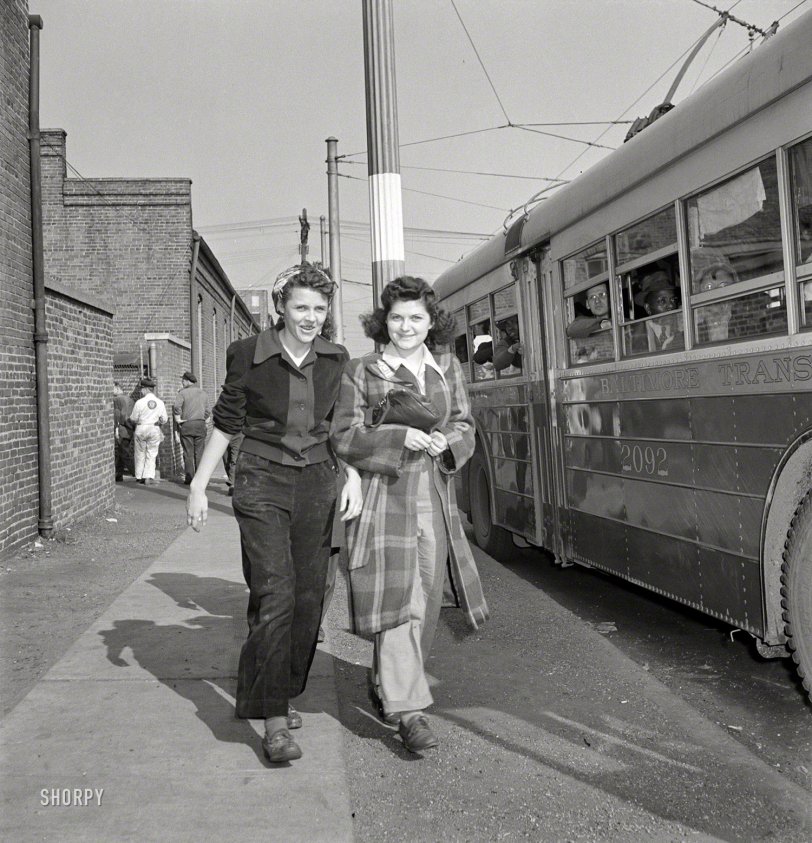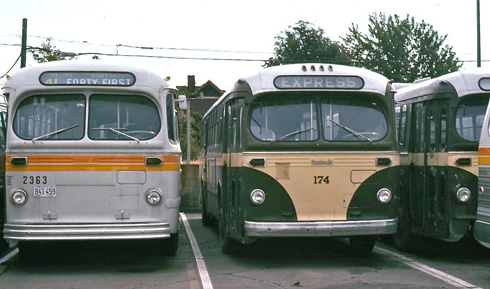


Framed or unframed, desk size to sofa size, printed by us in Arizona and Alabama since 2007. Explore now.
Shorpy is funded by you. Patreon contributors get an ad-free experience.
Learn more.

- Alas, hidden from view
- Exclusive pump
- Details, Details
- What's that building to the left of the tower?
- Coal Barges
- Bromo-Seltzer
- Inner harbor
- The Basin
- What a headache!
- Giant stepladder?
- Baldwin 62303
- Baldwin VO-1000
- Cold
- No expense spared
- Tough Guys
- Lost in Toyland
- And without gloves
- If I were a blindfolded time traveler
- Smoke Consumer Also Cooks
- Oh that stove!
- Possibly still there?
- What?!?
- $100 Reward
- Freeze Frame
- Texas Flyer wanted
- Just a Year Too Soon
- WWII -- Replacing men with women at the railroad crossing.
- Yes, Icing
- You kids drive me nuts!
- NOT An Easy Job
Print Emporium
Trackless Trolley: 1943

April 1943. "Baltimore, Maryland. Rushing to catch the trackless trolley home from work at 4 p.m." Basically an electric bus. Medium format nitrate negative by Marjory Collins for the Office of War Information. View full size.
Double-decker trolleys
As a kid growing up in Portsmouth England during the 1950s, I loved riding the double-decker trolleys. Up front, up top. When one of the arms fell off the overhead wires, the amazingly long re-attachment pole had to be hauled out of a long tube running down the side of the bus. It was all a bit too difficult to wield that long thing properly for some conductors, and the driver sometimes had to hop out and help, especially when the trolley-bus was far off its usual intended course, making it difficult to latch the fallen arm on the wire again.
Much quieter and quicker of course than the diesel buses used on other routes. When we emigrated to Canada, Halifax still had trolley buses, then in '68 they replaced them with the noisiest buses ever made, that GM thing with the big front window. Never was quiet in town again for 25 years with those braying things, which sounded like a thousand fingernails being torturously scraped across a blackboard. And they called it progress. It just made a totally annoying din and stank of diesel. If you lived on or near a street with a bus route, sleep was impossible until they shut down around midnight.
The trolley bus was my favourite. Never liked streetcars and screaming wheel flanges on turns with the clunking over points and each rail. Electric buses. We'll soon see them again for everyone's sanity, but probably the week after I start pushing up the daisies, worst luck.
Everyone but my wife agrees
This photo could not have been taken in 1943 because the young lady on the right HAS to be my wife, and she (allegedly) wasn't born back then. Regardless, that's the spitting image of my Rebecca at 19, except she never let her hair poof quite like a poodle, though it would be trivial to do so. I'm now starting to wonder if I'm married to the eternal woman, the "Methusalah Girl", based on this picture Dave.
Saskatoon to Vancouver
I was driving trolley buses in Vancouver in 1973 when we received the second-hand Canadian Car Brill trolleys from Saskatoon. They arrived in mint condition, and ran for another 11 years in Vancouver. The photo shows the original Saskatoon number and paint scheme on the right, and the new Vancouver version on the left.

Happy pair
These two are looking pretty happy after a day's work. Ms Collins got herself and us a delightful image.
Curbliner
When trolley buses were first introduced in Des Moines, Iowa, there was a contest to name them. The winner was "Curbliner," and it became common usage in the city. Don't know that they've ever been called by that name anywhere else.
Saskatoon Trolley Buses
They were called trolley buses around here too. The Saskatoon Transit System shut down street car operations here in 1950 and replaced them with trolley buses. I have mixed memories of them. Thet're generally quite nice to ride in and fairly quiet when compared to a diesel bus. On the other hand in a Saskatchewan winter they could be only slightly warmer than the outside air. As well it inevitably happened that the poles would jump off the overhead wiring in the winter due to ice build-up - usually at a turn or a junction point with another line - tying up traffic until the driver got the pole back in place.
Saskatoon eventually sold our trolley buses - made by Canadian Car & Foundry under license from Brill - in 1973, not quite 25 years after the street car service ended. In the typically foresighted manner of our local government the trolley bus system was scrapped during the 1973 energy crisis. The cars were sold to Vancouver still operates a trolley bus system.
Seattle still has lots
And also up the road in Vancouver, BC.
Still Rolling in Cambridge, Mass., too
Complete with sparking poles when the shoe comes off the wire. I was fascinated by these buses when I first moved here in 1981. Now they're just an everyday part of the scenery.
The bus looks like
a Pullman Standard, from about 1940. Rode them frequently in Milwaukee, Wisconsin as a lad during the early fifties. They were replaced later by larger Marmon Harringtons. These electric vehicles were very quick. Although I never witnessed such an occasion, I understand an aggressive driver could snap an axle on one if not careful.
The Trackless Trolley War Connection
The pictured trackless trolley was noteworthy in 1943 because it was one of very few such vehicles that were allowed to be constructed nationwide during the war because of metal and tire shortages. Baltimore was heavy on war production plants and needed more transit vehicles to move the masses to work (notice that they are women factory workers). The fact that these buses did not use gasoline, which was also in very short supply, further lent credence to their special government dispensation allowing them to be constructed. The builder was Pullman Standard Mfg. Co. of Worcester, Mass and this particular group was retired around 1958.
Glendale
I remember riding the trolley buses in Glendale, CA when I was small. Occasionally the trolley pole would jump off of the overhead wires and the driver would have to reach up, with a long pole, and reconnect the shoe to the power line. Very exiting for a small child, with all of the sparking and drama.
Still rolling
Vehicles of this type are still very much in use in San Francisco, where they're called "trolley buses." They're very good for climbing hills that regular diesel buses wouldn't be able to make.
Baltimore transit
Here is a link to baltimore streetcar museum:
http://www.baltimorestreetcar.org/carstock.html
http://www.trolleybuses.net/bal/bal.htm

Clever Marjory
Ms. Collins made good use of fill-in flash for this shot.
What's in a name?
We used to call them trolley buses. They seemed to be the transition from trolleys to gas/diesel powered buses.
























On Shorpy:
Today’s Top 5